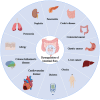Intestinal flora: a potential pathogenesis mechanism and treatment strategy for type 1 diabetes mellitus
- PMID: 39520706
- PMCID: PMC11552262
- DOI: 10.1080/19490976.2024.2423024
Intestinal flora: a potential pathogenesis mechanism and treatment strategy for type 1 diabetes mellitus
Abstract
Type 1 diabetes mellitus (T1DM) is a chronic autoimmune disease characterized by destruction of pancreatic β-cells, leading to insulin deficiency and hyperglycemia, and its incidence is increasing year by year. The pathogenesis of T1DM is complex, mainly including genetic and environmental factors. Intestinal flora is the largest microbial community in the human body and plays a very important role in human health and disease. In recent years, more and more studies have shown that intestinal flora and its metabolites, as an environmental factor, regulate the development of T1DM through various mechanisms such as altering the intestinal mucosal barrier, influencing insulin secretion and body immune regulation. Intestinal flora transplantation, probiotic supplementation, and other approaches to modulate the intestinal flora appear to be potential therapeutic approaches for T1DM. This article reviews the dysbiosis of the intestinal flora in T1DM, the potential mechanisms by which the intestinal flora affects T1DM, as well as discusses potential approaches to treating T1DM by intervening in the intestinal flora.
Keywords: Type 1 diabetes mellitus; autoimmune disease; intestinal flora; short-chain fatty acids.
Conflict of interest statement
No potential conflict of interest was reported by the author(s).
Figures
References
-
- Sun H, Saeedi P, Karuranga S, Pinkepank M, Ogurtsova K, Duncan BB, Stein C, Basit A, Chan JCN, Mbanya JC, et al. IDF diabetes atlas: global, regional and country-level diabetes prevalence estimates for 2021 and projections for 2045. Diabetes Res Clin Pract. 2022;183:109119. doi:10.1016/j.diabres.2021.109119. - DOI - PMC - PubMed
-
- Hormazábal-Aguayo I, Ezzatvar Y, Huerta-Uribe N, Ramírez-Vélez R, Izquierdo M, García-Hermoso A.. Incidence of type 1 diabetes mellitus in children and adolescents under 20 years of age across 55 countries from 2000 to 2022: a systematic review with meta-analysis. Diabetes Metab Res Rev. 2024;40(3):e3749. doi:10.1002/dmrr.3749. - DOI - PubMed
Publication types
MeSH terms
LinkOut - more resources
Full Text Sources
Medical



